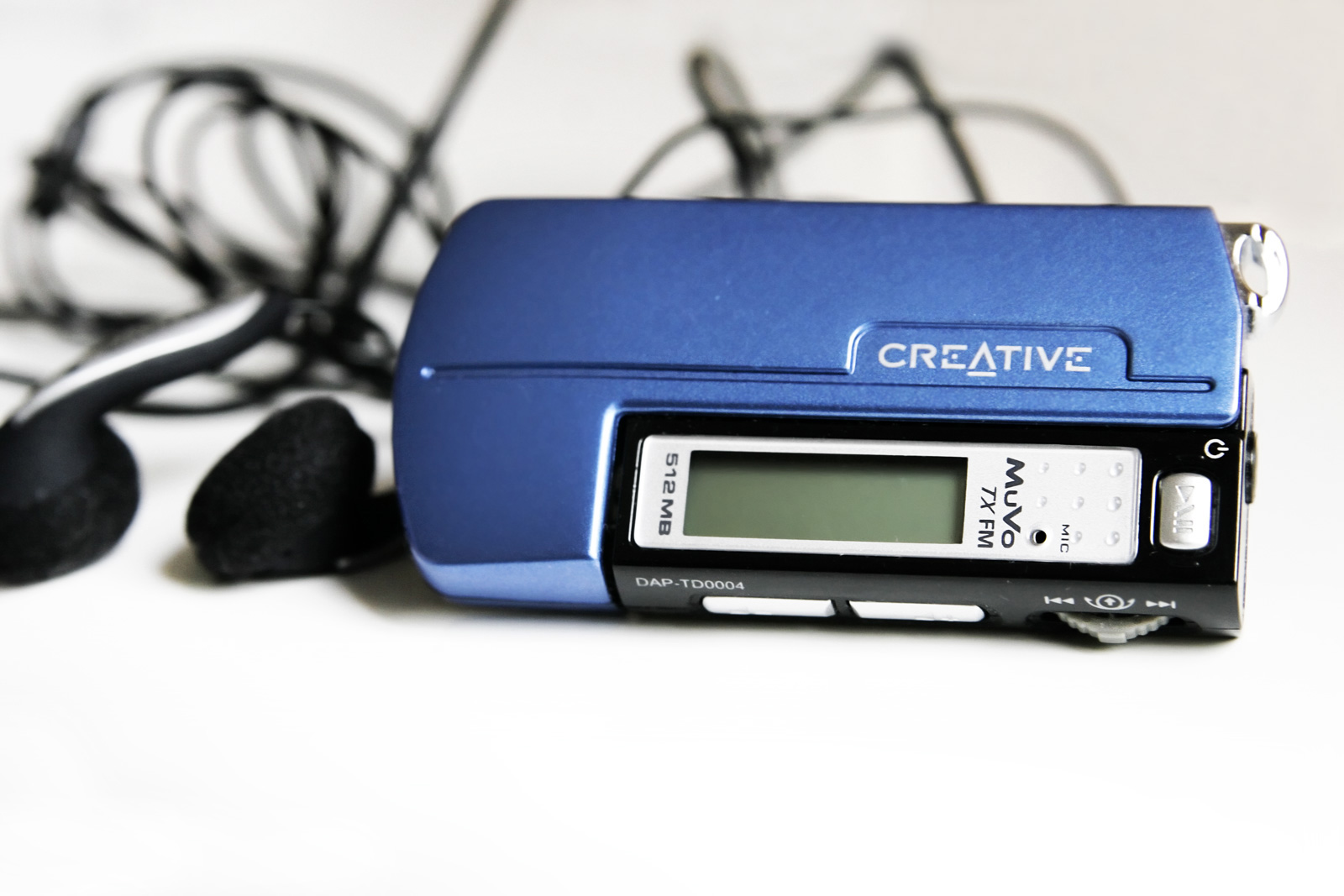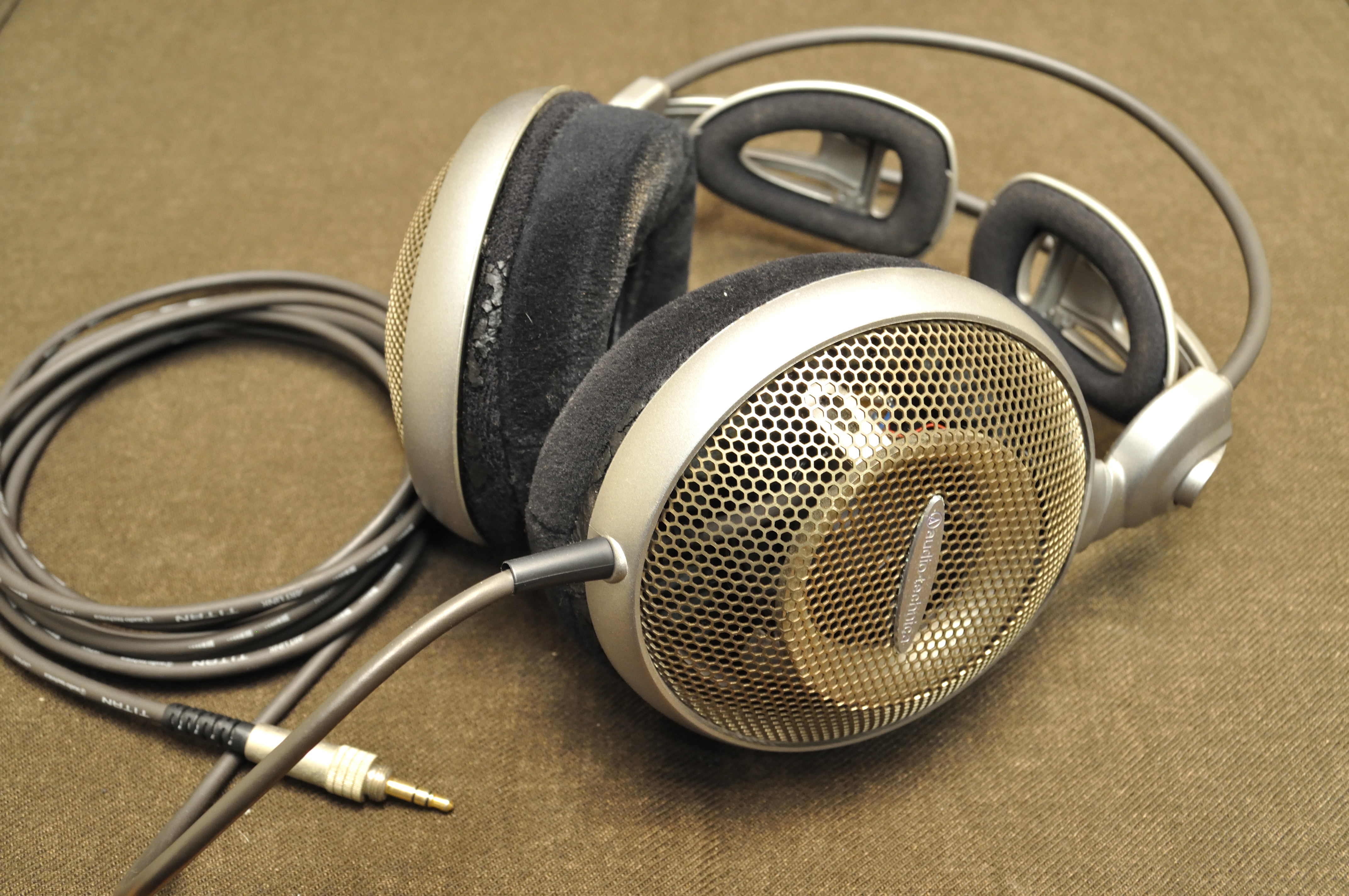|
Earphones
Headphones are a pair of small loudspeaker drivers worn on or around the head over a user's ears. They are electroacoustic transducers, which convert an electrical signal to a corresponding sound. Headphones let a single user listen to an audio source privately, in contrast to a loudspeaker, which emits sound into the open air for anyone nearby to hear. Headphones are also known as earphones or, colloquially, cans. Circumaural (around the ear) and supra-aural (over the ear) headphones use a band over the top of the head to hold the drivers in place. Another type, known as earbuds or earpieces, consists of individual units that plug into the user's ear canal; within that category have been developed cordless air buds using wireless technology. A third type are bone conduction headphones, which typically wrap around the back of the head and rest in front of the ear canal, leaving the ear canal open. In the context of telecommunication, a headset is a combination of a headpho ... [...More Info...] [...Related Items...] OR: [Wikipedia] [Google] [Baidu] |
Portable Media Player
A portable media player (PMP) or digital audio player (DAP) is a portable consumer electronics device capable of storing and playing digital media such as audio, images, and video files. Normally they refer to small, Electric battery, battery-powered devices utilising flash memory or a Hard disk drive, hard disk for storing various media Computer file, files. MP3 players has been a popular alternative name used for such devices, even if they also support other file formats and media types other than MP3 (for example Advanced Audio Coding, AAC, FLAC, Windows Media Audio, WMA). Generally speaking, PMPs are equipped with a 3.5 mm headphone jack which can be used for headphones or to connect to a boombox, home audio system, or connect to car audio and home High fidelity, stereos wired or via a wireless connection such as Bluetooth, and some may include radio tuners, voice recording and other features. In contrast, analogue portable audio players play music from non-digital m ... [...More Info...] [...Related Items...] OR: [Wikipedia] [Google] [Baidu] |
Loudspeaker
A loudspeaker (commonly referred to as a speaker or, more fully, a speaker system) is a combination of one or more speaker drivers, an enclosure, and electrical connections (possibly including a crossover network). The speaker driver is an electroacoustic transducer that converts an electrical audio signal into a corresponding sound. The driver is a linear motor connected to a diaphragm, which transmits the motor's movement to produce sound by moving air. An audio signal, typically originating from a microphone, recording, or radio broadcast, is electronically amplified to a power level sufficient to drive the motor, reproducing the sound corresponding to the original unamplified signal. This process functions as the inverse of a microphone. In fact, the ''dynamic speaker'' driver—the most common type—shares the same basic configuration as a dynamic microphone, which operates in reverse as a generator. The dynamic speaker was invented in 1925 by Edward W. Kellogg ... [...More Info...] [...Related Items...] OR: [Wikipedia] [Google] [Baidu] |
Headset (audio)
A headset is a combination of headphone and microphone. Headsets connect over a telephone or to a computer, allowing the user to speak and listen while keeping both hands free. They are commonly used in customer service and technical support centers, where employees can converse with customers while typing information into a computer. They are also common among computer gamers and let them talk with each other and hear others while using their keyboards and mice to play the game. Types Telephone headsets generally use loudspeakers with a narrower frequency range than those also used for entertainment. Stereo computer headsets, on the other hand, use 32-ohm speakers with a broader frequency range. Mono and stereo Headsets are available in single-earpiece and double-earpiece designs. Double-earpiece headsets may support stereo sound or use the same monaural audio channel for both ears. Single-earpiece headsets free up one ear, allowing better awareness of surroundings. Teleph ... [...More Info...] [...Related Items...] OR: [Wikipedia] [Google] [Baidu] |
CD Player
A CD player is an electronic device that plays audio compact discs, which are a digital audio, digital optical disc data storage format. CD players were first sold to consumers in 1982. CDs typically contain recordings of audio material such as music or audiobooks. CD players may be part of home stereo systems, car audio systems, personal computers, or portable CD players such as CD boomboxes. Most CD players produce an output signal via a headphone jack or RCA jacks. To use a CD player in a home stereo system, the user connects an RCA cable from the RCA jacks to a hi-fi (or other power amplifier, amplifier) and loudspeakers for listening to music. To listen to music using a CD player with a headphone output jack, the user plugs headphones or earphones into the headphone jack. Modern units can play audio formats other than the original CD PCM audio coding, such as MP3, Advanced Audio Coding, AAC and Windows Media Audio, WMA. DJs playing dance music at clubs often use specialize ... [...More Info...] [...Related Items...] OR: [Wikipedia] [Google] [Baidu] |
Radio
Radio is the technology of communicating using radio waves. Radio waves are electromagnetic waves of frequency between 3 hertz (Hz) and 300 gigahertz (GHz). They are generated by an electronic device called a transmitter connected to an antenna which radiates the waves. They can be received by other antennas connected to a radio receiver; this is the fundamental principle of radio communication. In addition to communication, radio is used for radar, radio navigation, remote control, remote sensing, and other applications. In radio communication, used in radio and television broadcasting, cell phones, two-way radios, wireless networking, and satellite communication, among numerous other uses, radio waves are used to carry information across space from a transmitter to a receiver, by modulating the radio signal (impressing an information signal on the radio wave by varying some aspect of the wave) in the transmitter. In radar, used to locate and track ob ... [...More Info...] [...Related Items...] OR: [Wikipedia] [Google] [Baidu] |
DECT
Digital Enhanced Cordless Telecommunications (DECT) is a cordless telephony standard maintained by ETSI. It originated in Europe, where it is the common standard, replacing earlier standards, such as CT1 and CT2. Since the DECT-2020 standard onwards, it also includes IoT communication. Beyond Europe, it has been adopted by Australia and most countries in Asia and South America. North American adoption was delayed by United States radio-frequency regulations. This forced development of a variation of DECT called DECT 6.0, using a slightly different frequency range, which makes these units incompatible with systems intended for use in other areas, even from the same manufacturer. DECT has almost completely replaced other standards in most countries where it is used, with the exception of North America. DECT was originally intended for fast roaming between networked base stations, and the first DECT product was Net3 wireless LAN. However, its most popular application is s ... [...More Info...] [...Related Items...] OR: [Wikipedia] [Google] [Baidu] |
FM Radio
FM broadcasting is a method of radio broadcasting that uses frequency modulation (FM) of the radio broadcast carrier wave. Invented in 1933 by American engineer Edwin Armstrong, wide-band FM is used worldwide to transmit high fidelity, high-fidelity sound over broadcast radio. FM broadcasting offers higher fidelity—more accurate reproduction of the original program sound—than other broadcasting techniques, such as AM broadcasting. It is also less susceptible to Electromagnetic interference, common forms of interference, having less static and popping sounds than are often heard on AM. Therefore, FM is used for most broadcasts of music and general audio (in the audio spectrum). FM radio stations use the very high frequency range of radio frequency, radio frequencies. Broadcast bands Throughout the world, the FM broadcast band falls within the VHF part of the radio spectrum. Usually 87.5 to 108.0 MHz is used, or some portion of it, with few exceptions: * In the Commo ... [...More Info...] [...Related Items...] OR: [Wikipedia] [Google] [Baidu] |
Switchboard Operator
In the early days of telephony, companies used manual telephone switchboards, and switchboard operators connected calls by inserting a pair of phone plugs into the appropriate jacks. They were gradually phased out and replaced by automated systems, first those allowing direct dialing within a local area, then for long-distance and international direct dialing. Description A typical manual telephone switchboard has a vertical panel containing an array of jacks with a desk in front. The desk has a row of switches and two rows of plugs attached to cables that retract into the desk when not in use. Each pair of plugs was part of a cord circuit with a switch associated that let the operator participate in the call or ring the circuit for an incoming call. Each jack had a light above it that lit when the customer's telephone receiver was lifted (the earliest systems required the customer to hand-crank a magneto to alert the central office and, later, to "ring off" the completed ca ... [...More Info...] [...Related Items...] OR: [Wikipedia] [Google] [Baidu] |
High Fidelity
High fidelity (hi-fi or, rarely, HiFi) is the high-quality reproduction of sound. It is popular with audiophiles and home audio enthusiasts. Ideally, high-fidelity equipment has inaudible noise and distortion, and a flat (neutral, uncolored) frequency response within the human hearing range. High fidelity contrasts with the lower-quality " lo-fi" sound produced by inexpensive audio equipment, AM radio, or the inferior quality of sound reproduction that can be heard in recordings made until the late 1940s. History Bell Laboratories began experimenting with various recording techniques in the early 1930s. Performances by Leopold Stokowski and the Philadelphia Orchestra were recorded in 1931 and 1932 using telephone lines between the Academy of Music in Philadelphia and the Bell labs in New Jersey. Some multitrack recordings were made on optical sound film, which led to new advances used primarily by MGM (as early as 1937) and Twentieth Century Fox Film Corporation (as ... [...More Info...] [...Related Items...] OR: [Wikipedia] [Google] [Baidu] |
Wireless
Wireless communication (or just wireless, when the context allows) is the transfer of information (''telecommunication'') between two or more points without the use of an electrical conductor, optical fiber or other continuous guided transmission medium, medium for the transfer. The most common wireless technologies use radio waves. With radio waves, intended distances can be short, such as a few meters for Bluetooth, or as far as millions of kilometers for NASA Deep Space Network, deep-space radio communications. It encompasses various types of fixed, mobile, and portable applications, including two-way radios, Mobile phone, cellular telephones, personal digital assistants (PDAs), and wireless networking. Other examples of applications of radio ''wireless technology'' include Global Positioning System, GPS units, garage door openers, wireless Mouse (computing), computer mouse, Keyboard (computing), keyboards and Headset (audio), headsets, headphones, radio receivers, satelli ... [...More Info...] [...Related Items...] OR: [Wikipedia] [Google] [Baidu] |
Audiophile
An audiophile (from + ) is a person who is enthusiastic about high-fidelity sound reproduction. The audiophile seeks to achieve high sound quality in the audio reproduction of recorded music, typically in a quiet listening space in a room with good acoustics. Audiophile values may be applied at all stages of music reproduction—the initial audio recording, the production process, the storage of sound data, and the playback (usually in a home setting). In general, the values of an audiophile are seen to be antithetical to the growing popularity of more convenient but lower-quality music, especially lossy digital file types like MP3, lower-definition music streaming services, laptop or cell phone speakers, and low-cost headphones. The term '' high-end audio'' refers to playback equipment used by audiophiles, which may be bought at specialist shops and websites. High-end components include turntables, digital-to-analog converters, equalization devices, preamplifiers and ... [...More Info...] [...Related Items...] OR: [Wikipedia] [Google] [Baidu] |











